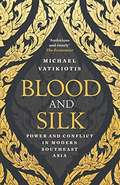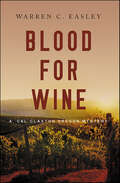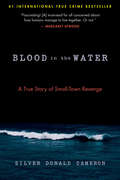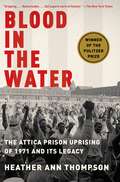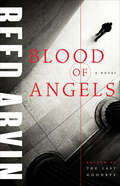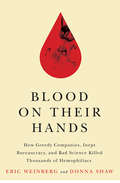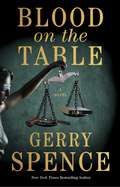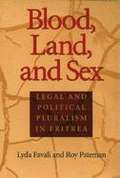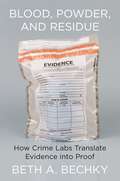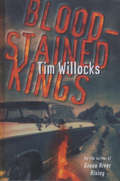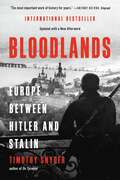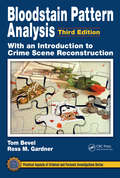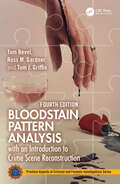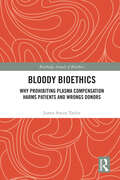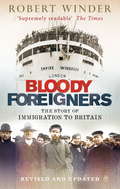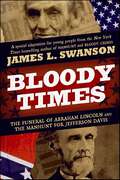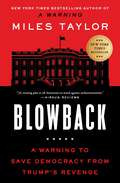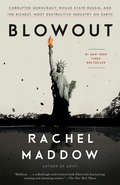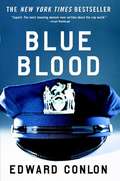- Table View
- List View
Blood and Silk: Power and Conflict in Modern Southeast Asia
by Michael Vatikiotis'A lively and learned guide to the politics, personalities and conflicts that are shaping a dynamic group of countries' FINANCIAL TIMES'A fascinating and many-layered portrait of Southeast Asia' THANT MYINT-UThought-provoking and eye-opening, BLOOD AND SILK is an accessible, personal look at modern Southeast Asia, written by one of the region's most experienced outside observers. This is a first-hand account of what it's like to sit at the table with deadly Thai Muslim insurgents, mediate between warring clans in the Southern Philippines and console the victims of political violence in Indonesia - all in an effort to negotiate peace, and understand the reasons behind endemic violence.Peering beyond brand new shopping malls and shiny glass towers in Bangkok and Jakarta, Michael Vatikiotis probes the heart of modern Southeast Asia. Why are the region's richest countries such as Malaysia riddled with corruption? Why do Myanmar, Thailand and the Philippines harbour unresolved violent insurgencies? How do deepening religious divisions in Indonesia and Malaysia and China's growing influence affect the region and the rest of the world?Vatikiotis tells the story of modern Southeast Asia using vivid portraits of the personalities who pull the strings, mixed with revealing analysis that is underpinned by decades of experience in the countries involved, from their silk-sheathed salons to blood-spattered streets. The result is a fascinating study of the dynamics of power and conflict in one of the world's fastest growing regions.
Blood for Wine (Cal Claxton Mysteries #5)
by Warren C EasleyNero Wolfe Award Finalist for 2018"Oenophiles and aspiring vintners will enjoy the wine lore in this well-wrought tale of love and betrayal." —Publishers WeeklyCal Claxton's old farmhouse sits high in Oregon's Red Hills, home of scores of wineries and some of the most coveted acreage for growing the pinot noir grape in the world. Former Los Angeles prosecutor Cal settled in this haven to reboot his life as a widower, growing a small practice that includes some pro bono work in nearby Portland. Life is good, filled with food, wine, and friends. But this beautiful area is not the idyllic haven it appears to be.When Cal's neighbor, Jim Kavanaugh, the owner and gifted vintner of an up-and-coming winery, is accused of murdering his wife, his freedom—and the grape harvest—is suddenly in jeopardy along with his reputation, and his business begins to slide. No gentleman farmer, this puts the rugged winemaker's property, his only financial asset, in play. When a blackmail plot is hatched against the owner of adjacent land, it begins to look like a brutal game of real-life Monopoly is underway.Cal agrees to defend Jim, a good friend, which pulls him reluctantly into the blackmail plot. Emotions are running high over Lori Kavanaugh's bloody death. There is no shortage of suspects. There may be more than the one game in play. And defending Jim might well make Cal the next target of a vicious, cunning killer.
Blood from Stone
by Frances FyfieldA twisting tale of suspense--perfect for fans of Linda Fairstein.When the body of a successful criminal lawyer is found outside a chic London hotel, it looks like a suicide. For those who knew her, the woman's death is a shock--Marianne Shearer was at the pinnacle of her career, wealthy and stylish--but for the police, the case is open-and-shut.There's something strange about the circumstances, though, something that prompts her colleague Peter Friel to dig deeper. Little by little, he discovers that things are not as they seem. In her final days, Marianne appears to have left a series of small, almost imperceptible clues--clues that point to a far more sinister truth.
Blood in the Water: A True Story of Small-Town Revenge
by Silver Donald Cameron&“Fascinating! [A] must-read for all concerned about how humans manage to live together. Or not.&” —Margaret Atwood&“Superb... an instant true crime classic.&” —Publishers Weekly (starred review) A masterfully told true story, perfect for fans of Say Nothing and Furious Hours: a brutal murder in a small Nova Scotia fishing community raises urgent questions of right and wrong, and even the very nature of good and evil.In his riveting and meticulously reported final book, Silver Donald Cameron offers a stunning, intricate narrative about a notorious killing and its devastating repercussions. Cameron&’s searing, utterly gripping story about one small community raises a disturbing question: Are there times when taking the law into your own hands is not only understandable but the responsible thing to do? In June 2013, three upstanding citizens of a small town on Cape Breton Island murdered their neighbor, Phillip Boudreau, at sea. While out checking their lobster traps, two Landry cousins and skipper Dwayne Samson saw Boudreau in his boat, the Midnight Slider, about to vandalize their lobster traps. Like so many times before, the small-time criminal was about to cost them thousands of dollars out of their seasonal livelihood. Boudreau seemed invincible, a miscreant who would plague the village forever. Meanwhile the police and local officials were frustrated, cowed, and hobbled by shrinking budgets. One of the men took out a rifle and fired four shots at Boudreau and his boat. Was the Boudreau killing cold blooded murder, a direct reaction to credible threats, or the tragic result of local officials failing to protect the community? As many local people have said, if those fellows hadn't killed him, someone else would have...
Blood in the Water: The Attica Prison Uprising of 1971 and Its Legacy
by Heather Ann ThompsonNATIONAL BOOK AWARD FINALIST * NEW YORK TIMES NOTABLE BOOK FOR 2016 * NAMED A BEST BOOK OF THE YEAR BY THE BOSTON GLOBE, NEWSWEEK, KIRKUS, AND PUBLISHERS WEEKLYTHE FIRST DEFINITIVE HISTORY OF THE INFAMOUS 1971 ATTICA PRISON UPRISING, THE STATE’S VIOLENT RESPONSE, AND THE VICTIMS’ DECADES-LONG QUEST FOR JUSTICE On September 9, 1971, nearly 1,300 prisoners took over the Attica Correctional Facility in upstate New York to protest years of mistreatment. Holding guards and civilian employees hostage, the prisoners negotiated with officials for improved conditions during the four long days and nights that followed. On September 13, the state abruptly sent hundreds of heavily armed troopers and correction officers to retake the prison by force. Their gunfire killed thirty-nine men—hostages as well as prisoners—and severely wounded more than one hundred others. In the ensuing hours, weeks, and months, troopers and officers brutally retaliated against the prisoners. And, ultimately, New York State authorities prosecuted only the prisoners, never once bringing charges against the officials involved in the retaking and its aftermath and neglecting to provide support to the survivors and the families of the men who had been killed. Drawing from more than a decade of extensive research, historian Heather Ann Thompson sheds new light on every aspect of the uprising and its legacy, giving voice to all those who took part in this forty-five-year fight for justice: prisoners, former hostages, families of the victims, lawyers and judges, and state officials and members of law enforcement. Blood in the Water is the searing and indelible account of one of the most important civil rights stories of the last century.(With black-and-white photos throughout)
Blood in the Water: The Attica Prison Uprising of 1971 and Its Legacy
by Heather Ann ThompsonThe first definitive account of the infamous 1971 Attica prison uprising, the state's violent response, and the victims' decades-long quest for justice--including information never released to the public--published to coincide with the forty-fifth anniversary of this historic event.On September 9, 1971, nearly 1,300 prisoners took over the Attica Correctional Facility in upstate New York to protest years of mistreatment. Holding guards and civilian employees hostage, during the four long days and nights that followed, the inmates negotiated with state officials for improved living conditions. On September 13, the state abruptly ended talks and sent hundreds of heavily armed state troopers and corrections officers to retake the prison by force. In the ensuing gunfire, thirty-nine men were killed--hostages as well as prisoners--and close to one hundred were severely injured. After the prison was secured, troopers and officers brutally retaliated against the prisoners during the weeks that followed. For decades afterward, instead of charging any state employee who had committed murder or carried out egregious human rights abuses, New York officials prosecuted only the prisoners and failed to provide necessary support to the hostage survivors or the families of any of the men who'd been killed. Heather Ann Thompson sheds new light on one of the most important civil rights stories of the last century, exploring every aspect of the uprising and its legacy from the perspectives of all of those involved in this forty-five-year fight for justice: the prisoners, the state officials, the lawyers on both sides, the state troopers and corrections officers, and the families of the slain men. (With black-and-white illustrations throughout)"Superb . . . Gripping . . . Remarkable . . . Not all works of history have something to say so directly to the present, but Heather Ann Thompson's Blood in the Water: The Attica Prison Uprising of 1971 and Its Legacy, which deals with racial conflict, mass incarceration, police brutality and dissembling politicians, reads like it was special-ordered for the sweltering summer of 2016." --Mark Oppenheimer, The New York Times From the Hardcover edition.
Blood of Angels
by Reed Arvin“...another winner that thriller, mystery and general fiction readers alike will relish.” — Publishers Weekly (starred review)“Arvin weaves together disparate elements into a coherent and often thought-provoking tale.” — Pittsburgh Tribune“Intriguing...clever. A-” — Entertainment Weekly“A suspenseful story line that takes hold of the reader from the very beginning to the book’s close.” — New York Law Journal“(BLOOD OF ANGELS is) the kind of book that makes ‘unputdownable’ and ‘page-turner’more than just cliches.” — Chicago Tribune Books“Fast-paced action, unexpected twists…keeps the pages turning until the end.” — Denver Post“Tense, evocative prose...fiendishly clever and eloquently penned. — Providence Journal“Arvin weaves his plot and his chacters together with remarkable empathy...A legal thriller with soul.” — Wichita Eagle“An old-fashioned thriller with modern-technology smarts.” — Chicago Tribune Books“...the first summer-movie blockbuster of the year.” — Kirkus Reviews (Starred Review)“Absorbing...briskly paced (with) realistic characters whose fervent beliefs shape their actions.” — The Record (Bergen County, NJ)“Arvin piles on the action in this nail-biting Tennessee tale of misplaced revenge.” — New Orleans Times-Picayune“The pace is fast and...Arvin saves a satisfying surprise for the finale.” — Boston Globe“Briskly-paced...a fresh approach to the thriller.” — Fort Lauderdale Sun-Sentinel“This nail-biter is Arvin’s third thriller...and each has been better than the last.” — Booklist (starred review)“Arvin keeps the action swift and the tension high.” — Calgary Sun
Blood on Their Hands: How Greedy Companies, Inept Bureaucracy, and Bad Science Killed Thousands of Hemophiliacs
by Eric Weinberg Donna ShawA few short years after HIV first entered the world blood supply in the late 1970s and early 1980s, over half the hemophiliacs in the United States were infected with the virus. But this was far more than just an unforeseeable public health disaster. Negligent doctors, government regulators, and Big Pharma all had a hand in this devastating epidemic. Blood on Their Hands is an inspiring, firsthand account of the legal battles fought on behalf of hemophiliacs who were unwittingly infected with tainted blood. As part of the team behind the key class action litigation filed by the infected, young New Jersey lawyer Eric Weinberg was faced with a daunting task: to prove the negligence of a powerful, well-connected global industry worth billions. Weinberg and journalist Donna Shaw tell the dramatic story of how idealistic attorneys and their heroic, mortally-ill clients fought to achieve justice and prevent further infections. A stunning exposé of one of the American medical system’s most shameful debacles, Blood on Their Hands is a rousing reminder that, through perseverance, the victims of corporate greed can sometimes achieve great victory.
Blood on the Table: A Novel
by Gerry SpenceBlood on the Table brings to life the same powerful emotions and riveting excitement that Gerry Spence evoked from juries when the blood was real. Blood on the Table is a blend of darkness, sex, and violence, with characters who are far from perfect and often are their own worst enemies. Spence takes the reader to savage—back country Wyoming, where an eleven-year-old boy must take the witness stand against a vicious prosecutor, corrupt police, and a prejudiced judge, to keep his family safe.At the Publisher's request, this title is being sold without Digital Rights Management Software (DRM) applied.
Blood, Land, and Sex: Legal and Political Pluralism in Eritrea
by Lyda Favali Roy PatemanEritrea is a small country in northeast Africa on the Red Sea across from Yemen; it has a population of about 3.5 million. Its capital is Asmara. Djibouti is to its southeast, Ethiopia to its south and Sudan to its west. Eritrea's population was in the past organized on the kinship system and has been under Italian and Ethiopian domination but is now independent. This small country has many languages, many customs and several religions. In Eritrea, State, traditional, and religious laws are equally prevalent, but any one legal system may be put into play depending upon the individual or individuals involved in a legal dispute. Because of conflicting laws, it has been difficult for Eritreans to come to a consensus on what constitutes their legal system. In this book, the authors examine the roles of the state, ethnic groups, religious groups, and the international community in several key areas of Eritrean law--blood feud and murder, land tenure, gender relations (marriage, prostitution, rape), and female genital mutilation. Favali and Pateman explore the intersections of the various laws and discuss how change can be brought to communities where legal ambiguity prevails, often to the grave harm of women and other powerless individuals. This significant book focuses on how Eritrea and other newly emerging democracies might build pluralist legal systems that will be acceptable to an ethnically and religiously diverse population. LYDA FAVALI is a lawyer and researcher at the University of Turin, Italy. ROY PATEMAN is Professor Emeritus of Political Science at the University of California, Los Angeles.
Blood, Powder, and Residue: How Crime Labs Translate Evidence into Proof
by Beth A. BechkyA rare behind-the-scenes look at the work of forensic scientistsThe findings of forensic science—from DNA profiles and chemical identifications of illegal drugs to comparisons of bullets, fingerprints, and shoeprints—are widely used in police investigations and courtroom proceedings. While we recognize the significance of this evidence for criminal justice, the actual work of forensic scientists is rarely examined and largely misunderstood. Blood, Powder, and Residue goes inside a metropolitan crime laboratory to shed light on the complex social forces that underlie the analysis of forensic evidence.Drawing on eighteen months of rigorous fieldwork in a crime lab of a major metro area, Beth Bechky tells the stories of the forensic scientists who struggle to deliver unbiased science while under intense pressure from adversarial lawyers, escalating standards of evidence, and critical public scrutiny. Bechky brings to life the daily challenges these scientists face, from the painstaking screening and testing of evidence to making communal decisions about writing up the lab report, all while worrying about attorneys asking them uninformed questions in court. She shows how the work of forensic scientists is fraught with the tensions of serving justice—constantly having to anticipate the expectations of the world of law and the assumptions of the public—while also staying true to their scientific ideals.Blood, Powder, and Residue offers a vivid and sometimes harrowing picture of the lives of highly trained experts tasked with translating their knowledge for others who depend on it to deliver justice.
Blood-Stained Kings
by Tim WillocksTom Willock’s first book, Green River Rising, earned the kind of reviews that are rarely accorded to most so-called literary thrillers. This remarkable debut was hailed for its rich, powerful writing as well as its dramatic, page-turning suspense. The New York Times Book Review called it “beautifully vivid” and “triumphantly realized,” while People called it “as fine a thriller as one could ask for.” The author’s much-anticipated second novel is as powerful and ambitious as its predecessor. Set in New Orleans and the rural South, it is the story of a chain of cataclysmic events let loose by the murder of Clarence Jefferson, a legendary lawman who has gathered a cache of evidence that could imprison corrupt politicians in five states. His last act, it appears, was to handpick two people as the unlucky heirs of his potentially explosive evidence files. The pair must either dispose of them as fast as they can or—at considerable risk to themselves—deliver the files to the authorities. Lenna Parillaud and Dr. Cicero Grimes, Jefferson’s “beneficiaries,” have never met. Lenna, a millionaire businesswoman, has been racked by grief and rage over the loss of her daughter. Dr. Grimes is a clinically depressed psychiatrist. Though both have burdens enough of their own, they are swept up into this story of Southern violence, passion, and vengeance, the likes of which perhaps only the readers of Willocks’s previous novel can imagine. Compared by critics to Norman Mailer, James Ellroy, Stephen Hunter, and Andrew Vachss, Willocks offers a unique amalgam of gritty realism and something more—a depth and intensity that is seldom achieved in popular fiction.
Bloodlands: Europe Between Hitler and Stalin
by Timothy SnyderAmericans think of World War II as "The Good War. ” But before it even began, America’s ally Stalin had shot and starved millions of his own citizens; he would continue to do so throughout the war. American soldiers liberated concentration camps, but they never reached the death factories, killing fields, and starvation sites in the East where Hitler and Stalin murdered civilians on a massive scale. In twelve years, in deliberate killing policies unrelated to combat, the Nazi and Soviet regimes killed fourteen million people in a zone of death between Berlin and Moscow. At war’s end, these bloodlands fell behind the iron curtain, leaving their history in darkness. In Bloodlands, acclaimed historian Timothy Snyder offers a groundbreaking investigation of the place where Europeans were murdered by the millions, providing a fresh account of the atrocities perpetrated by the two regimes. Assiduously researched, deeply humane, and utterly definitive, Bloodlands is required reading for anyone seeking to understand the central tragedy of modern history.
Bloodstain Pattern Analysis with an Introduction to Crime Scene Reconstruction (ISSN)
by Ross M. Gardner Tom BevelObjective establishment of the truth is the goal of any good crime scene investigator. This demands a consideration of all evidence available using proven scientific methodologies to establish objective snapshots of the crime. The majority of forensic disciplines shed light on thewho of a crime, bloodstain pattern analysis is one of the most imp
Bloodstain Pattern Analysis with an Introduction to Crime Scene Reconstruction (Practical Aspects of Criminal and Forensic Investigations)
by Ross M. Gardner Tom Bevel Tom J. GriffinBlood Stain Pattern Analysis with an Introduction to Crime Scene Reconstruction, Fourth Edition provides criminal investigators and forensic scientists with a complete and comprehensive handbook on bloodstain pattern analysis.Bringing over 90 combined years of practical experience—and thousands of cases worked collectively—the authors explain the complex mechanics of blood spatter analysis, including anatomical issues relative to bloodstain pattern analysis, a discussion of blood and the circulatory system, and the nature of bleeding associated with various traumatic and non-traumatic injuries. The book also details specific methodologies for crime scene analysis and reconstruction, explaining the proven methodology involved in the process. Such methodology is built upon scientific method and provides focus and structure to the analyst as they evaluate evidence and conduct their work and the investigation.Finally, all chapters are fully revised and updated to address the latest taxonomy and terminology, with over 400 full-color photographs included to illustrate the dynamics of bloodstain pattern analysis.Key features: Presents a specific and detailed taxonomy of bloodstain pattern characteristics, outlining recently updated NIST’s OSAC terminology Includes two full-color fold-outs Decision Map to guide analysts through the classification process Details the theory, principles, and methodology for crime scene reconstruction Expands the bloodstain on clothing chapter, to include new developments in the understanding of bloodstain features and characteristics on cloth Offering practical advice and tips for new and experienced professionals alike, Blood Stain Pattern Analysis with an Introduction to Crime Scene Reconstruction, Fourth Edition offers readers the necessary tools to guide and focus any investigative effort.
Bloodtaking and Peacemaking: Feud, Law, and Society in Saga Iceland
by William Ian MillerDubbed by the New York Times as "one of the most sought-after legal academics in the county," William Ian Miller presents the arcane worlds of the Old Norse studies in a way sure to attract the interest of a wide range of readers. Bloodtaking and Peacemaking delves beneath the chaos and brutality of the Norse world to discover a complex interplay of ordering and disordering impulses. Miller's unique and engaging readings of ancient Iceland's sagas and extensive legal code reconstruct and illuminate the society that produced them. People in the saga world negotiated a maze of violent possibility, with strategies that frequently put life and limb in the balance. But there was a paradox in striking the balance-one could not get even without going one better. Miller shows how blood vengeance, law, and peacemaking were inextricably bound together in the feuding process. This book offers fascinating insights into the politics of a stateless society, its methods of social control, and the role that a uniquely sophisticated and self-conscious law played in the construction of Icelandic society. "Illuminating. "-Rory McTurk, Times Literary Supplement "An impressive achievement in ethnohistory; it is an amalgam of historical research with legal and anthropological interpretation. What is more, and rarer, is that it is a pleasure to read due to the inclusion of narrative case material from the sagas themselves. "-Dan Bauer, Journal of Interdisciplinary History
Bloody Bioethics: Why Prohibiting Plasma Compensation Harms Patients and Wrongs Donors (Routledge Annals of Bioethics)
by James Stacey TaylorThis is the first book to argue in favor of paying people for their blood plasma. It does not merely argue that offering compensation to plasma donors is morally permissible. It argues that prohibiting donor compensation is morally wrong—and that it is morally wrong for all of the reasons that are offered against allowing donor compensation. Opponents of donor compensation claim that it will reduce the amount and quality of plasma obtained, exploit and coerce donors, and undermine social cohesion. James Stacey Taylor argues that empirical evidence demonstrates that compensating plasma donors greatly increases the amount of plasma obtained with no adverse effects on the quality of the pharmaceutical products that are manufactured from it. Prohibiting compensation thus harms patients by reducing their access to the medicines they need. He also argues that it is the prohibition of compensation—not its offer—that exploits donors, fails to respect the moral need to secure a person’s authoritative consent to her treatment, and prevents donors from giving their informed consent to donate. Prohibiting compensation thus not only harms patients but also wrongs donors. Bloody Bioethics will appeal to researchers, advanced students, and medical professionals interested in bioethics, moral philosophy, and the moral limits of markets.
Bloody Foreigners: The Story of Immigration to Britain
by Robert WinderImmigration is one of the most important stories of modern British life, yet it has been happening since Caesar first landed in 53 BC. Ever since the first Roman, Saxon, Jute and Dane leaped off a boat we have been a mongrel nation. Our roots are a tangled web. From Huguenot weavers fleeing French Catholic persecution in the 18th century to South African dentists to Indian shopkeepers; from Jews in York in the 12th century (who had to wear a yellow star to distinguish them and who were shamefully expelled by Edward I in 1272) to the Jamaican who came on board the Windrush in 1947. The first Indian MP was elected in 1892, Walter Tull, the first black football player played (for Spurs and Northampton) before WW1 (and died heroically fighting for the allies in the last months of the war); in 1768 there were 20,000 black people in London (out of a population of 600,000 - a similar percentage to today). The 19th century brought huge numbers of Italians, Irish, Jews (from Russia and Poland mainly), Germans and Poles. This book draws all their stories together in a compelling narrative.
Bloody Foreigners: The Story of Immigration to Britain
by Robert WinderImmigration is one of the most important stories of modern British life, yet it has been happening since Caesar first landed in 53 BC. Ever since the first Roman, Saxon, Jute and Dane leaped off a boat we have been a mongrel nation. Our roots are a tangled web. From Huguenot weavers fleeing French Catholic persecution in the 18th century to South African dentists to Indian shopkeepers; from Jews in York in the 12th century (who had to wear a yellow star to distinguish them and who were shamefully expelled by Edward I in 1272) to the Jamaican who came on board the Windrush in 1947. The first Indian MP was elected in 1892, Walter Tull, the first black football player played (for Spurs and Northampton) before WW1 (and died heroically fighting for the allies in the last months of the war); in 1768 there were 20,000 black people in London (out of a population of 600,000 - a similar percentage to today). The 19th century brought huge numbers of Italians, Irish, Jews (from Russia and Poland mainly), Germans and Poles. This book draws all their stories together in a compelling narrative.
Bloody Times: The Funeral of Abraham Lincoln and the Manhunt for Jefferson Davis
by James L. SwansonNew York Times bestselling author James L. Swanson brings to life the fast-paced, suspense-filled story of Abraham Lincoln's and Jefferson Davis's final journeys through our wounded nation following the Civil War. This middle grade nonfiction book is an excellent choice for tween readers in grades 7 to 8, especially during homeschooling. It’s a fun way to keep your child entertained and engaged while not in the classroom.This suspense-filled true-crime thriller—the young readers’ adaptation of Swanson’s BloodyCrimes—explores two epic events of the Civil War era: the manhunt to apprehend Confederate president Jefferson Davis in the wake of Abraham Lincoln’s assassination and the momentous 20-day funeral pageant that brought President Lincoln’s body from Washington, DC to his home in Springfield. Full of fascinating twists and turns, and lavishly illustrated with dozens of rare historical images, Bloody Times captures the riveting stories of these two fallen leaders who changed the course of history. It’s perfect for young readers who enjoy dramatic nonfiction tales from the likes of Steve Sheinkin and Patricia McCormick.This book contains a note from the author, a glossary, a list of important Civil War figures, and a guide to visiting the historic sites mentioned within. A companion to the bestselling and highly acclaimed Chasing Lincoln's Killer.
Blowback: A Warning to Save Democracy from the Next Trump
by Miles TaylorINSTANT NEW YORK TIMES BESTSELLER The author behind the &“eye-popping&” (CNN) #1 New York Times bestseller A Warning presents an urgent look at how our deeply divided nation is setting the stage for &“The Next Trump.&”Donald Trump will be president again, whether he is on the ballot or not. That is because Trumpism is overtaking the Republican Party and will mount a vigorous comeback, potentially in the hands of a savvier successor—The Next Trump. This prophecy will come true, according to Miles Taylor, if we do not learn the lessons of the recent past. With the 2024 election approaching, the formerly &“Anonymous&” official is back with bombshell revelations and a sobering national forecast. Through interviews with dozens of ex-Trump aides and government leaders, Taylor predicts what could happen inside &“Trump 2.0,&” the White House of a more competent and more formidable copycat. What sounds like a political thriller—from shadowy presidential powers and CIA betrayals to angry henchmen and assassination plots—is instead America&’s political reality, as Taylor uses untold stories to shed light on the ex-President&’s unfulfilled plans, the dark forces haunting our civic lives, and how we can thwart the rise of extremism in the United States. Blowback is also a surprisingly emotional and self-critical portrait of a dissenter, whose own unmasking provides a vivid warning about what happens when we hide the truth from others and, most importantly, ourselves.
Blowing Up Everything Is Beautiful: Israel's Extermination of Gaza
by James RobinsTHEY TOLD YOU WHAT THEY WERE DOING WHILE THEY DID IT &“Blow up and flatten everything . . .&” These chilling words, said by Amichai Eliyahu, a minister in the Israeli government, have been a message to the world and the people of Gaza: destroying everything—homes, businesses, lives—is justified. Even beautiful. For fifteen months and in full view of the world, the state of Israel trapped more than two million people in a tiny strip of land and unleashed vengeance on them. The Palestinians endured a nightmare—bombed from the air, targeted by soldiers, their hospitals destroyed—and, as they are cut off from the rest of the world, the nightmare continues.Blowing Up Everything is Beautiful is a searing indictment of the brutality and atrocities inflicted on the Palestinians of Gaza and the collaboration of powerful nations in their murder. With forensic detail and the forceful arguments of a prosecutor, James Robins details how the ongoing attempt to annihilate Gaza became the major crime of our age—and a turning point. What happens when the moral regime of international law and human rights that protect the oppressed fails? Blowing Up Everything is Beautiful reveals a bold, radical, and independent new voice that offers a powerful reminder: all crimes cry out for justice, and if that justice fails, the crimes will no doubt happen again.
Blowout: Corrupted Democracy, Rogue State Russia, and the Richest, Most Destructive Industry on Earth
by Rachel MaddowBig Oil and Gas Versus Democracy—Winner Take All <P><P>In 2010, the words “earthquake swarm” entered the lexicon in Oklahoma. That same year, a trove of Michael Jackson memorabilia—including his iconic crystal-encrusted white glove—was sold at auction for over $1 million to a guy who was, officially, just the lowly forestry minister of the tiny nation of Equatorial Guinea. And in 2014, Ukrainian revolutionaries raided the palace of their ousted president and found a zoo of peacocks, gilded toilets, and a floating restaurant modeled after a Spanish galleon. <P><P>Unlikely as it might seem, there is a thread connecting these events, and Rachel Maddow follows it to its crooked source: the unimaginably lucrative and equally corrupting oil and gas industry. With her trademark black humor, Maddow takes us on a switchback journey around the globe, revealing the greed and incompetence of Big Oil and Gas along the way, and drawing a surprising conclusion about why the Russian government hacked the 2016 U.S. election. She deftly shows how Russia’s rich reserves of crude have, paradoxically, stunted its growth, forcing Putin to maintain his power by spreading Russia’s rot into its rivals, its neighbors, the West’s most important alliances, and the United States. <P><P>Chevron, BP, and a host of other industry players get their star turn, most notably ExxonMobil and the deceptively well-behaved Rex Tillerson. The oil and gas industry has weakened democracies in developed and developing countries, fouled oceans and rivers, and propped up authoritarian thieves and killers. But being outraged at it is, according to Maddow, “like being indignant when a lion takes down and eats a gazelle. You can’t really blame the lion. It’s in her nature.” <P><P>Blowout is a call to contain the lion: to stop subsidizing the wealthiest businesses on earth, to fight for transparency, and to check the influence of the world’s most destructive industry and its enablers. The stakes have never been higher. As Maddow writes, “Democracy either wins this one or disappears.” <P><P><b>A New York Times Bestseller</b>
Blue Blood
by Edward ConlonEdward Conlon's Blue Blood is an ambitious and extraordinary work of nonfiction about what it means to protect, to serve, and to defend among the ranks of New York's finest. This is an anecdotal history of New York as experienced through its police force, and depicts a portrait of the teeming street life of the city in all its horror and splendor. It is a story about police politics, fathers and sons, partners who become brothers, old ghosts and undying legacies.
Blue Book on AI and Rule of Law in the World (Artificial Intelligence and the Rule of Law)
by Cui YadongThis book focuses on the development of artificial intelligence and rule of law in the world, by collecting and summarizing the information about the development of artificial intelligence and rule of law in China and the world, covering topics like AI strategy, policy, law, theoretical research, practical application, etc. It makes an in-depth analysis so as to provide an objective, fair, and accurate report. The purpose is to promote the study of AI and law, promote the construction of AI and rule of law system, and create an AI and rule of law environment. In particular, it aims to play an active role in promoting the establishment of legislative norms, legal systems, policy systems, and ethical norms that are compatible with the innovative development of AI, promoting the implementation of a new generation of national AI development strategies and ensuring the safe, reliable, controllable, healthy, and sustainable development of AI. It is hoped that this book provides a useful reference for researchers of AI and law.
